|
|
|
 |
|
 |
Navigation: Contents: Info: Here is a list of all the constellations that can be seen
from the UK throught out the year, Some are only visible at
certain times. On the map images, click on the Messier
numbers to get an image of that object. At the moment only
the Messier catalog is included, but in the future, the
Caldwell Catalog will be added.
A quick guide around the sky: To find your way around the night sky you
need to be able to find at least one constellation, that is
Ursa Major. This is proberbly the most famous of the
constellatons and can be used to find many more. Below is a
quick guide to finding a few constellations and the
celestial objects they contain. How to find Polaris How to find the Andromeda
Galaxy How to find Arcturus How to find the
Pleiades How to find Gemini How to find Cepheus How to find Leo How to find Auriga
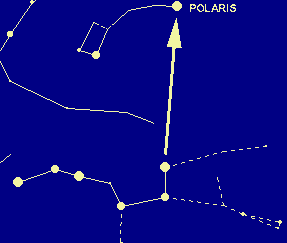 Polaris or the Pole Star is the brightest member of Ursa
Minor or the Little Bear. It lies almost directly over the
north pole on the Earth, so it is a very important star to
aid navigation. To find it you first need to locate Ursa
Major or the Little Bear. Ursa Major is a large and
reasonably bright constellation that resembles a plough, and
is often called the Plough or the Big Dipper. Once you have
found it, line up the two bright stars that make up the
right hand side of the square trough. Imagine a line passing
through these two stars and follow it upwards, you should
find a reasonably bright star. This is the Pole Star. If you
then draw an imaginary line from this star to your horizon,
you have found the direction of North. You can then estimate
where East, South and West lie on the horizon.
Polaris or the Pole Star is the brightest member of Ursa
Minor or the Little Bear. It lies almost directly over the
north pole on the Earth, so it is a very important star to
aid navigation. To find it you first need to locate Ursa
Major or the Little Bear. Ursa Major is a large and
reasonably bright constellation that resembles a plough, and
is often called the Plough or the Big Dipper. Once you have
found it, line up the two bright stars that make up the
right hand side of the square trough. Imagine a line passing
through these two stars and follow it upwards, you should
find a reasonably bright star. This is the Pole Star. If you
then draw an imaginary line from this star to your horizon,
you have found the direction of North. You can then estimate
where East, South and West lie on the horizon.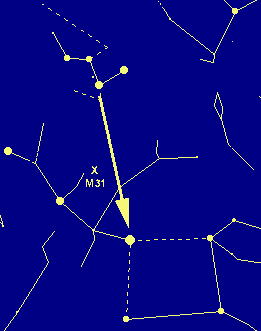 M31, the Andromeda Galaxy is a large galaxy which is part of
our Local Group of galaxies. It is spiral in shape and is
infact the most distant object visible to the naked eye. It
is thought that it resembles our own Milky Way. To find it,
first find Cassiopeia the W shaped constellation which is
fairly bright. Line up the two downward strokes of the W and
follow the line you will come to a bright star which is part
of the Square Of Pegasus. Now travel East counting three
stars, the bright one from the square, then a dim one and
finaly another bright one. Once there move upwards about the
same distance again and you should come accross a fuzzy
patch close to a dim star. This is the Andromeda Galaxy. You
can tell why Charles Messier wanted to log all these fuzzy
objects, because they look remarkably like comets, which is
what he was actually hunting for.
M31, the Andromeda Galaxy is a large galaxy which is part of
our Local Group of galaxies. It is spiral in shape and is
infact the most distant object visible to the naked eye. It
is thought that it resembles our own Milky Way. To find it,
first find Cassiopeia the W shaped constellation which is
fairly bright. Line up the two downward strokes of the W and
follow the line you will come to a bright star which is part
of the Square Of Pegasus. Now travel East counting three
stars, the bright one from the square, then a dim one and
finaly another bright one. Once there move upwards about the
same distance again and you should come accross a fuzzy
patch close to a dim star. This is the Andromeda Galaxy. You
can tell why Charles Messier wanted to log all these fuzzy
objects, because they look remarkably like comets, which is
what he was actually hunting for.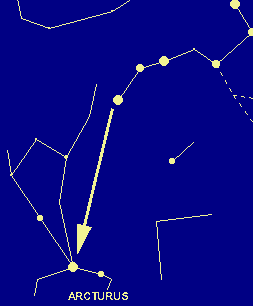 Arcturus is one of the most luminous stars in the sky and is
the brightest that makes up the constellation of Bootes. To
find it, line up the last two stars on the handle of the Big
Dipper and continue East. You will come accros a very bright
star which is Arcturus.
Arcturus is one of the most luminous stars in the sky and is
the brightest that makes up the constellation of Bootes. To
find it, line up the last two stars on the handle of the Big
Dipper and continue East. You will come accros a very bright
star which is Arcturus.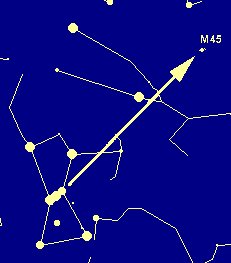 One
of the most impressive clusters of stars in the night sky is
the Pleiades or M45. This is an open cluster of new stars
surrounded by Hydrogen and Helium gas. Stars are being born
here all the time. The cluster some times goes by the name
of the Seven Sisters which some people mistake for the seven
brightest stars that make up the cluster. The two brightest
stars are infact the Mother and Father and the other more
dim stars are the seven sisters. This cluster can be seen
with the naked eye in the constellation of Taurus. To find
it firstly locate Orion the Hunter. In the center of Orion
is the belt, made up of three bright stars in a row. Line
these up and continue upwards. You will pass a bright star
called Aldebaran, keep going and you will come accross a
patch of stars tightly packed together. Try and count as
many stars as you can with the naked eye and then look
through a pair of binoculars you will see many more.
One
of the most impressive clusters of stars in the night sky is
the Pleiades or M45. This is an open cluster of new stars
surrounded by Hydrogen and Helium gas. Stars are being born
here all the time. The cluster some times goes by the name
of the Seven Sisters which some people mistake for the seven
brightest stars that make up the cluster. The two brightest
stars are infact the Mother and Father and the other more
dim stars are the seven sisters. This cluster can be seen
with the naked eye in the constellation of Taurus. To find
it firstly locate Orion the Hunter. In the center of Orion
is the belt, made up of three bright stars in a row. Line
these up and continue upwards. You will pass a bright star
called Aldebaran, keep going and you will come accross a
patch of stars tightly packed together. Try and count as
many stars as you can with the naked eye and then look
through a pair of binoculars you will see many more.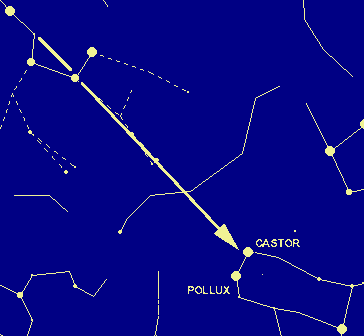 Gemini
the Twin is one of the constellations that make up the
Zodiac. The two brightest stars that make it up are Castor
and Pollux. To find Gemini, line up the top left and bottom
right stars in the trough of Ursa Major. Continue this line
and you will come accros the two bright stars of Gemini.
Gemini
the Twin is one of the constellations that make up the
Zodiac. The two brightest stars that make it up are Castor
and Pollux. To find Gemini, line up the top left and bottom
right stars in the trough of Ursa Major. Continue this line
and you will come accros the two bright stars of Gemini.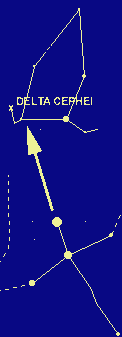 The
constellation of Cepheus holds one of the prized discoveries
in astronomy, the star Delta Cephei. This is a pulsating
star that has a very acurate period. Astronomers discovered
that the period of these pulsations are directly linked to
their absolute brightness. Knowing this brightness, the
stars distance can be calculated. These stars have been
observed in nearby galaxies by the Hubble Telescope to help
determine their distance from us and so find a more acurate
value for the expansion of the universe. Delta Cephei can be
observed quite easily using a pair of binoculars and
measurements can be took over a period of a couple of weeks.
To find Delta Cephei and the constellation Cepheus firstly
locate Cygnus the Swan. Cygnus is a cross shape with five
bright stars making it up. Follow the crosss shape upwards
and you will find a house shape with a bright star at the
bottom right. Move to the left and you will see a more
dimmer star, left again and then up a little. The ease of
finding Delta Cephei realy depends on where in its' cycle it
is at that moment.
The
constellation of Cepheus holds one of the prized discoveries
in astronomy, the star Delta Cephei. This is a pulsating
star that has a very acurate period. Astronomers discovered
that the period of these pulsations are directly linked to
their absolute brightness. Knowing this brightness, the
stars distance can be calculated. These stars have been
observed in nearby galaxies by the Hubble Telescope to help
determine their distance from us and so find a more acurate
value for the expansion of the universe. Delta Cephei can be
observed quite easily using a pair of binoculars and
measurements can be took over a period of a couple of weeks.
To find Delta Cephei and the constellation Cepheus firstly
locate Cygnus the Swan. Cygnus is a cross shape with five
bright stars making it up. Follow the crosss shape upwards
and you will find a house shape with a bright star at the
bottom right. Move to the left and you will see a more
dimmer star, left again and then up a little. The ease of
finding Delta Cephei realy depends on where in its' cycle it
is at that moment.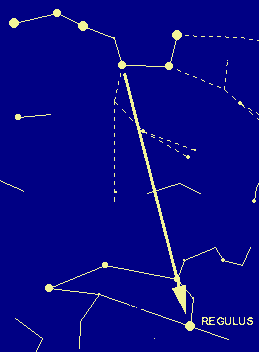 Using
Ursa Major again, follow the two leftmost stars that make up
the trough. Follow the line downwards and you will find the
bright star Regulus. Once you have found this , you should
quite easily be able to make out the shape of Leo the Lion.
Its' head is the mirrored question mark above Regulus.
Using
Ursa Major again, follow the two leftmost stars that make up
the trough. Follow the line downwards and you will find the
bright star Regulus. Once you have found this , you should
quite easily be able to make out the shape of Leo the Lion.
Its' head is the mirrored question mark above Regulus.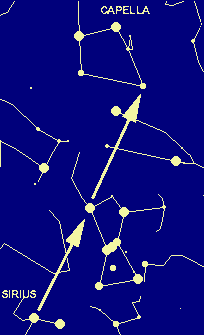 Using
Ursa Major again, follow the two leftmost stars that make up
the trough. Follow the line downwards and you will find the
bright star Regulus. Once you have found this , you should
quite easily be able to make out the shape of Leo the Lion.
Its' head is the mirrored question mark above Regulus.
Using
Ursa Major again, follow the two leftmost stars that make up
the trough. Follow the line downwards and you will find the
bright star Regulus. Once you have found this , you should
quite easily be able to make out the shape of Leo the Lion.
Its' head is the mirrored question mark above Regulus.
[ QUANTUMWEB SOFTWARE | QUANTUMWEB PUBLISHING ]